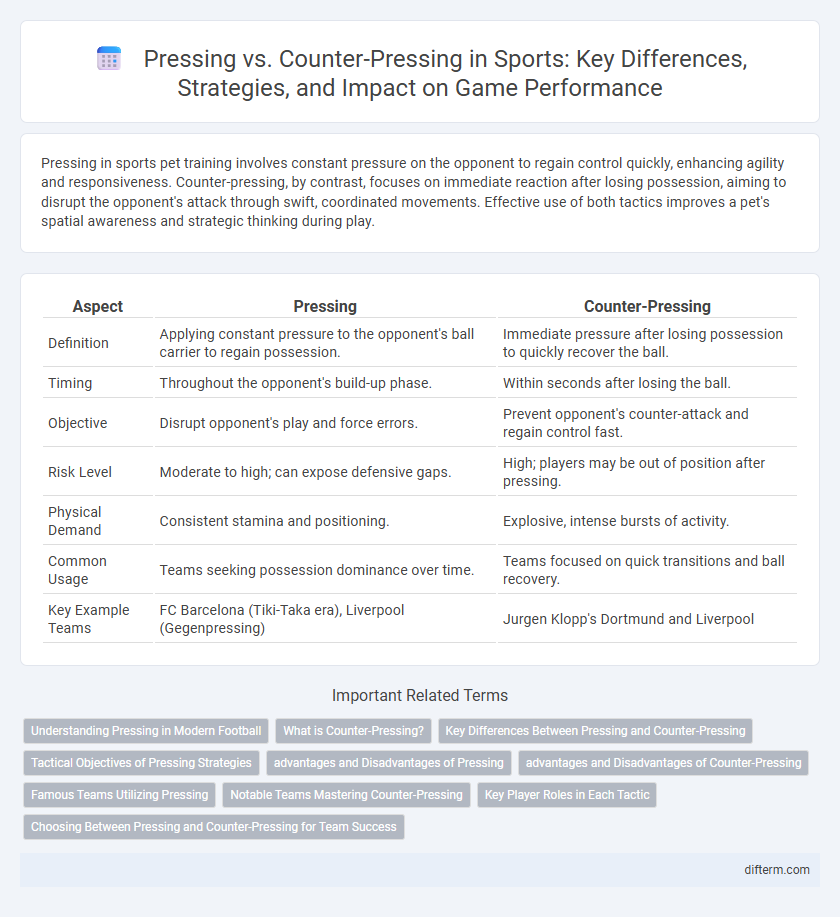Pressing in sports pet training involves constant pressure on the opponent to regain control quickly, enhancing agility and responsiveness. Counter-pressing, by contrast, focuses on immediate reaction after losing possession, aiming to disrupt the opponent's attack through swift, coordinated movements. Effective use of both tactics improves a pet's spatial awareness and strategic thinking during play.
Table of Comparison
| Aspect | Pressing | Counter-Pressing |
|---|---|---|
| Definition | Applying constant pressure to the opponent's ball carrier to regain possession. | Immediate pressure after losing possession to quickly recover the ball. |
| Timing | Throughout the opponent's build-up phase. | Within seconds after losing the ball. |
| Objective | Disrupt opponent's play and force errors. | Prevent opponent's counter-attack and regain control fast. |
| Risk Level | Moderate to high; can expose defensive gaps. | High; players may be out of position after pressing. |
| Physical Demand | Consistent stamina and positioning. | Explosive, intense bursts of activity. |
| Common Usage | Teams seeking possession dominance over time. | Teams focused on quick transitions and ball recovery. |
| Key Example Teams | FC Barcelona (Tiki-Taka era), Liverpool (Gegenpressing) | Jurgen Klopp's Dortmund and Liverpool |
Understanding Pressing in Modern Football
Pressing in modern football involves a coordinated team effort to apply immediate pressure on the opponent possessing the ball, aiming to disrupt their build-up play and regain possession quickly. Effective pressing relies on tactical discipline, high-intensity energy, and synchronized movements to close down passing lanes and force errors in dangerous areas. This strategy enhances defensive solidity while increasing the likelihood of creating scoring opportunities through quick turnovers.
What is Counter-Pressing?
Counter-pressing, also known as gegenpressing, is a tactical approach in football where a team immediately attempts to regain possession after losing the ball by applying intense, coordinated pressure on the opponent. This strategy aims to exploit the transitional moments when the opposing team is vulnerable and unorganized, minimizing their time and space to create attacking opportunities. Teams like Liverpool under Jurgen Klopp have popularized counter-pressing, emphasizing collective pressing to disrupt the opponent's buildup play and initiate quick attacking moves.
Key Differences Between Pressing and Counter-Pressing
Pressing involves a proactive defensive tactic where players immediately apply pressure to opponents in possession to regain the ball quickly, focusing on positioning and anticipation. Counter-pressing, or gegenpressing, occurs right after losing possession, with the team aggressively pressing the opponent to disrupt their transition and recover control swiftly. Key differences include timing and intent: pressing is continuous throughout the game, while counter-pressing is a reactive strategy executed in the first moments after losing the ball.
Tactical Objectives of Pressing Strategies
Pressing in football aims to quickly regain possession by applying high pressure on opponents, disrupting their build-up play and forcing errors in dangerous zones. Counter-pressing, also known as gegenpressing, focuses on immediate pressure after losing the ball to prevent counter-attacks and quickly recover possession in midfield areas. Both strategies optimize spatial control and player positioning to maintain team compactness and increase transition speed.
advantages and Disadvantages of Pressing
Pressing in soccer enhances defensive pressure by forcing opponents into errors and reducing their time on the ball, which can disrupt their build-up play effectively. However, pressing requires high physical stamina and coordination, often leaving spaces that skilled opponents can exploit during quick counterattacks. Teams employing pressing must balance aggression and positional discipline to avoid vulnerability, as excessive commitment can lead to defensive disorganization.
advantages and Disadvantages of Counter-Pressing
Counter-pressing offers the advantage of quickly regaining possession by immediately pressuring opponents after losing the ball, disrupting their transition and increasing goal-scoring opportunities. However, it demands high physical exertion and tactical discipline, which can lead to player fatigue and vulnerability to well-organized counterattacks if the press is bypassed. Teams must balance intensity and stamina to effectively implement counter-pressing without compromising defensive stability.
Famous Teams Utilizing Pressing
Famous teams like Liverpool and Bayern Munich have mastered pressing, using high-intensity pressure to regain possession quickly and disrupt opponents' buildup play. Liverpool's relentless pressing under Jurgen Klopp, often called "gegenpressing," emphasizes immediate pressure after losing the ball to create turnovers in dangerous areas. Bayern Munich combines tactical discipline with aggressive pressing to dominate possession and control the tempo of matches.
Notable Teams Mastering Counter-Pressing
Notable teams mastering counter-pressing include Liverpool under Jurgen Klopp, who popularized the intense "gegenpressing" style, and Borussia Dortmund, which executes swift ball recovery immediately after losing possession. These teams emphasize aggressive, coordinated pressure to regain control in advanced positions, disrupting opponents' attacks. Their success showcases counter-pressing's effectiveness in modern football tactics for dominating possession and creating scoring opportunities.
Key Player Roles in Each Tactic
Pressing demands aggressive forwards and midfielders who excel in high-intensity runs and quick decision-making to close down opponents rapidly. Counter-pressing relies heavily on defensive midfielders and center-backs with exceptional anticipation and tackling skills to regain possession immediately after losing the ball. In both tactics, the coordination between key roles like strikers, wingers, and holding midfielders is crucial to disrupt the opponent's rhythm and create transitional attacking opportunities.
Choosing Between Pressing and Counter-Pressing for Team Success
Choosing between pressing and counter-pressing hinges on a team's tactical identity, player fitness, and opposition style. Pressing demands high stamina and coordination to maintain constant pressure, effectively disrupting the opponent's buildup, while counter-pressing focuses on immediate ball recovery after losing possession, leveraging quick transitions and tactical awareness. Analyzing match data on possession loss locations, player recovery speed, and spatial control enhances decision-making to maximize team success in various competitive scenarios.
Pressing vs Counter-Pressing Infographic

 difterm.com
difterm.com